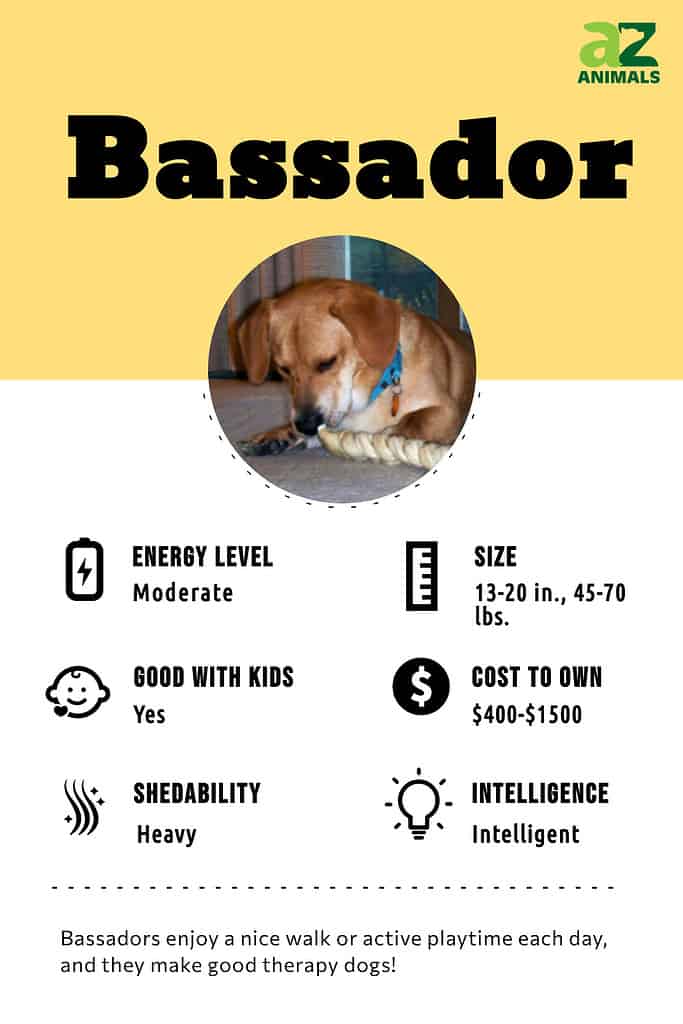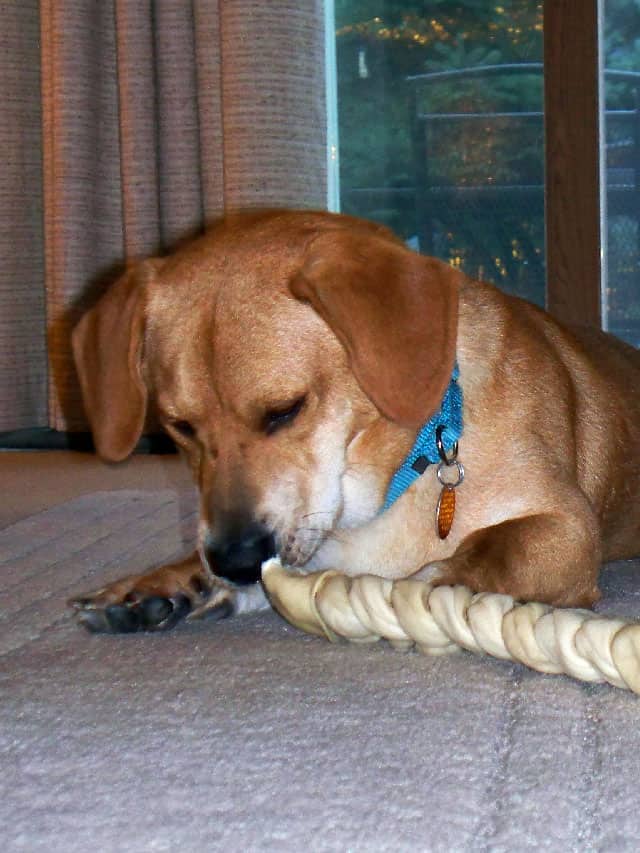Bassador
Canis lupus
This dog is also known as a Bassetdor or a Basset Lab.
Advertisement
Bassador Scientific Classification
- Kingdom
- Animalia
- Phylum
- Chordata
- Class
- Mammalia
- Order
- Carnivora
- Family
- Canidae
- Genus
- Canis
- Scientific Name
- Canis lupus
Read our Complete Guide to Classification of Animals.
Bassador Conservation Status
Bassador Facts
- Fun Fact
- This dog is also known as a Bassetdor or a Basset Lab.
- Temperament
- Friendly, outgoing, and loyal
- Diet
- Omnivore
Bassador as a Pet:
- General Health
- Energy Level
- Shedability
- Trainability
- Intelligence
- Tendency to Chew
- Size
- Family and kid friendliness
- Yappiness / Barking
- Moderate
- Separation Anxiety
- Moderate
- Preferred Temperature
- Average climate
- Exercise Needs
- Moderate
- Friendly With Other Dogs
- Moderate
- Pure bred cost to own
- $700 to $1,500
- Dog group
- Non-sporting
- Male weight
- 45-70 lbs
- Female weight
- 45-70 lbs
This post may contain affiliate links to our partners like Chewy, Amazon, and others. Purchasing through these helps us further the A-Z Animals mission to educate about the world's species.
View all of the Bassador images!
While Basset Hounds and Labrador Retrievers may breed naturally on their own, human breeders began to intentionally cross them on a large scale starting in the late 1990s.

The dutiful and friendly Bassador is the fusion of two unlikely and unrelated breeds: a Basset Hound and a Labrador Retriever. The Basset Hound is a low-slung dog, originating from France and Belgium, with huge, droopy ears, an elongated body, a wrinkled brow, and almost sorrowful-looking eyes. The Labrador Retriever, by contrast, is a tall, spirited, well-proportioned breed that was first bred in Newfoundland, Canada as a duck retriever and fisherman’s companion.
See all of our expert product reviews.
The common term for a mix of two purebred dogs that combines elements from both is a designer dog. In this case, the Bassador will probably inherit a low frame and some drooping features from the Basset Hound, although its head looks a bit like a Lab. The short and dense fur comes in a variety of different colors and markings. If it’s bred from a yellow Lab, then the dog will have a white and yellow base coat mixed with black and brown markings. If it’s bred from a black Lab, then the dog will probably have a black base coat with white or yellow colors mixed in.
3 Pros and Cons of Ownership
| Pros | Cons |
|---|---|
| Outgoing and Friendly The Bassador has a natural desire to express itself around people. | Strong Prey Drive The Bassador has an unfortunate tendency to chase down anything it perceives as prey. |
| Loyal This mix tends to be very protective of its owner. | Stubborn This dog sometimes has a mind of its own. |
| Athletic This dog is a good playmate and exercise companion, but it also knows how to settle down. | Heavy Shedder This breed has dense fur that sheds constantly. |
Size and Weight
The Bassador is a medium-sized dog with the long, low-slung shape of a Basset Hound. Males may be slightly heavier than females, but there is also a lot more variation between individuals.
| Height (Male) | 13 to 20 inches |
| Height (Female) | 13 to 20 inches |
| Weight (Male) | 45 to 70 pounds |
| Weight (Female) | 45 to 70 pounds |
Common Health Issues
The Bassador is a fairly healthy dog with a lifespan of around 10 to 12 years. As a mix, it may inherit any of the health problems from its two parent breeds, including glaucoma, allergies, cancer, ear infections, back problems, dermatitis, ectropion (excess drooping of the lower eyelid), hip dysplasia (a genetic condition that causes the hip joint to become partially or fully dislocated), and bloating (a very serious condition that can cause the stomach to expand rapidly). A good breeder will try to eliminate or reduce the chances of some genetic conditions arising, but no dog is completely free of at least some predisposition to health problems. In summation, these are the most common issues to look out for:
- Allergies
- Ear Infections
- Back Problems
- Glaucoma
- Cancer
Temperament, Personality, and Behavior

The Bassador exhibits unwavering loyalty, a fun-loving personality, and the characteristics of a good watchdog.
©Svea Neitzke/Shutterstock.com
Health and Entertainment for your Bassador
See all of our expert product reviews.
The Bassador is an outgoing and genial companion who will exhibit an unwavering loyalty toward its friends and family. Its fun-loving personality and playful behavior are best matched for an active and engaged owner. Depending on which traits it inherits from its parents, the Bassador might be slightly guarded around strangers, but this can be overcome with a little time and effort (as well as proper training as a puppy). Its tendency to bark or howl when a stranger approaches the home also makes it a good watchdog.
A bassador can have a wide range of personalities just like most pets. Both labs and bassets are generally good-natured dogs that love to hunt. However, the bassador is more of an independent thinker and can sometimes be a stubborn companion.
Although stubborn, as long as your bassador puppy is well socialized and trained as a puppy there is no doubt that it will be friendly and trainable.
In appearance, bassadors are usually short and stocky with front legs that may turn inward a little bit. There may also be visible ears and a long to medium length tail.
Care
The bassador is recommended most of all for owners with some prior experience caring for dogs. Its heavy shedding, its somewhat stubborn demeanor, and its need for lots of playtime and attention all require a highly engaged and attentive owner.
Bassador puppies should almost always be purchased from a high-quality breeder with an excellent reputation in your area. If you need more information before making a purchase, then you should ask the breeder for proof of the dogs’ health and lineage. It is not a good idea to buy from a low-quality breeder or puppy mill. While you may be saving money in the short term, these dogs are more likely to develop health problems, which will cost you in the long run.
If price is a concern, then you might want to consider adopting a dog from a shelter or rescue. Bassadors might sometimes show up at a general shelter or a Basset or Labrador-specific group.
If you have any other questions or concerns about your dog’s care, then you should consult with your vet. You should also plan on having regular physical examinations at the vet even when your dog appears otherwise healthy.
Best Dog Food
The Bassador needs high-quality dog food, preferably one that’s specially formulated for fairly energetic dogs. The exact amount will depend on the dog’s size, age, and activity level. The Bassador has no other special dietary needs, but it is recommended to prepare multiple meals throughout the day. This should hopefully minimize the chances of bloating if your dog is prone to it. Owners should not feed it more than necessary, since the dog may have a tendency to gain weight.
To satisfy this breed’s appetite for a healthy weight and head-to-toe wellbeing, the A-Z Animals pick for the best Bassador dog food is Merrick Backcountry Raw Infused Healthy Grains Dry Dog Food.
This high-energy formula is nutritious and delicious enough to keep Bassadors happy and playful. It’s less processed with raw pieces and wholesome ingredients so your dog will get everything it needs and nothing it doesn’t. The taurine is good for the eyes, since Bassadors can experience glaucoma. And amino acids lend themselves to a shiny coat.
Check Chewy or Amazon for this product.
- Freeze-dried raw coated kibble and raw pieces
- Beef, lamb, and rabbit with wholesome grains
- No peas or lentils
Maintenance and Grooming
Sporting a dense and heavy shedding coat, the Bassador needs to be brushed at least once a week to remove dead and loose hair. During the heavy shedding season of the spring and fall, the frequency should be increased to about once a day. Owners will also need to check the ears and brush the teeth almost every single day to maintain proper health. The nails should be trimmed less often, around once or twice a month. If they start clicking on the floor, then the nails are already too long.
Training
In terms of the ease with which it can be trained, the bassador tends to fall somewhere in the middle of the spectrum. It may inherit some stubbornness of the basset hound or the more compliant and trainable nature of the Labrador retriever, but generally this breed will require some patience and understanding to get the most out of it. Owners should try to minimize or eliminate the dog’s worst tendencies, including its strong prey drive and chewing behavior.
Crate training might also be a good idea if you plan to crate the dog for at least an hour each day. As with many other dogs, the bassador will respond best to positive reinforcement methods like praise and treats. Negative training methods might just discourage it or cause it to become unresponsive. If you are struggling to train it yourself, then you might want to solicit the help of a professional trainer.
Exercise
The bassador’s energy level varies considerably based on its inherited traits, but it will usually need about 30 to 60 minutes of exercise every single day. This can be done through a mixture of long walks and shorter playtime. The bassador does best with a fenced yard to run around in. Owners should be cautious about letting it off the leash since its strong prey drive might take over and override its training. The bassador’s dense coat can tolerate all types of climates, but it might have a tendency to become uncomfortable in hot weather, so prepare for plenty of rest and shade in the summer.
Puppies
As a designer dog, the characteristics of Bassador puppies can be a bit unpredictable. You may not even know what behavioral and personality traits it has inherited until after you’ve already brought your dog home, so you should definitely be prepared for the entire range of different possible characteristics. The bassador needs to be trained and socialized from an early age in order to become a well-behaved and functioning adult.
Children
The Bassador loves to bask in the attention of children. Provided everyone shares in the responsibility of its care, this is a good dog for the entire family.
Similar Dogs
If you’re a fan of the Bassador, then you might also want to consider the following mixes:
- Basset Retriever – A mixture between a Basset Hound and a Golden Retriever is a fairly athletic and intelligent dog in the mold of the Bassador. It is also a friendly and eager family companion.
- Basset Shepherd – Sporting the black and brown coat of its German Shepherd parent, this unusual mix is a very alert, loyal, and intelligent dog that should form a strong bond with its owner. It also needs plenty of care and interactions from its human companions throughout the day.
- Aussie Basset – A cross between a Basset Hound and an Australian Shepherd, this friendly, intelligent, and athletic dog thrives off the companionship and attention of people.
Popular Names
If you are looking for a good name for your Bassador, then you might want to consider one of the following options:
- Daisy
- Charlie
- Bella
- Lucy
- Cooper
- Buddy
- Luna
- Gus
- Duke
- Penny
Bassador FAQs (Frequently Asked Questions)
What is a Bassador?
The Bassador is a cross between a Basset Hound and a Labrador Retriever. While it will have a somewhat unpredictable mix of features from both breeds, the most common characteristics are a low but muscular frame, dense fur, and a friendly, outgoing personality. The average lifespan is around 10 to 12 years.
What is the price of a Bassador?
A new Bassador will probably cost you somewhere between $700 and $1,500. Dogs with stronger pedigrees may end up costing a lot more, but for most purposes, you shouldn’t need to pay more than the average price for a pet and companion.
Are Bassadors lazy?
Despite the sometimes unfair reputation of its Bassett Hound parent as a lazy breed, the Bassador is a fairly energetic dog with moderate exercise needs. As long as it gets enough physical activity every day, this breed knows how to settle down and lounge around the home with its owner.
Are Bassadors good family dogs?
The Bassador is an excellent family dog and a great companion for both kids and adults. In fact, the entire family can share the responsibility of caring for its needs.
Do Bassadors shed?
Yes, the Bassador is a heavy shedder and needs to be groomed constantly, especially in the shedding seasons of spring and fall.
Thank you for reading! Have some feedback for us? Contact the AZ Animals editorial team.
Sources
- Doggie Designer, Available here: https://doggiedesigner.com/bassador/
- Wag Walking, Available here: https://wagwalking.com/breed/bassador-basset-hound-and-labrador-retriever-mix


















